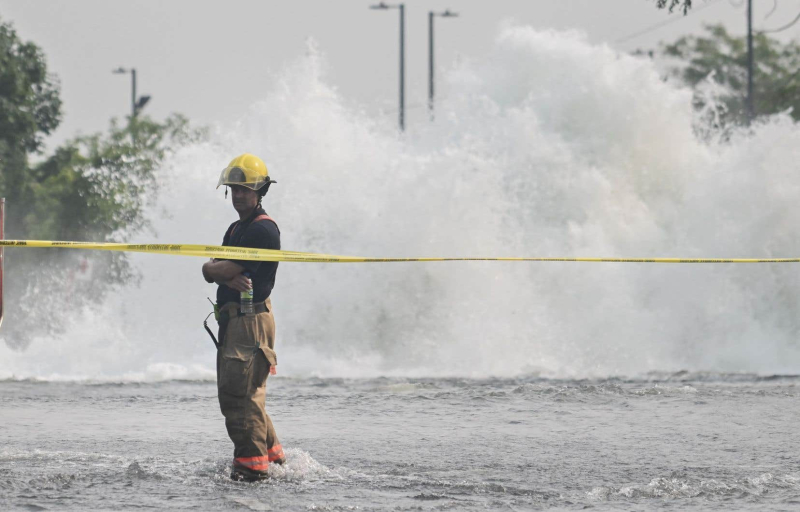
Photo: Graham Hughes The Canadian Press A firefighter observes the geyser caused last Friday by the rupture of a major water main.
Jeanne Corriveau
Published yesterday at 6:30 PM Updated yesterday at 9:26 PM
- Montreal
The water main that burst last Friday in Montreal may have been rated A, the best, but this data did not allow for determining its real condition, maintains the City of Montreal. Degradation had been observed during an inspection in 2017, but this main should have been able to hold up until 2030, estimate the authorities, who are still trying to understand the reason for the premature corrosion of the infrastructure.
On Tuesday, the Water Department wanted to clarify the rating system used to categorize all the pipes. The segment that suffered a break had an A rating, the highest according to the methodology established by the Ministry of Municipal Affairs, which is based on the number of breaks and the age of the pipes.
The City uses these ratings to develop its interventions to be carried out on secondary pipes, but it does not rely on them for large-diameter main pipes, because other criteria must be taken into account, explained Chantal Morissette, Director of the Water Department for the City of Montreal. “Our 84-inch pipe had never broken and it was only 40 years old. So, this conduct was category A. But that is not the category we use to make our decisions,” she said.
Broken cables
Electromagnetic inspections conducted in 2007 and 2017 on the water main that burst last Friday showed deterioration of steel cables surrounding the 2.1-metre-diameter pipe. The 2007 inspection of the 6.1-metre segment of the pipe located under René-Lévesque Boulevard, near De Lorimier Avenue, revealed that 15 of the 510 cables had failed. By 2017, that number had climbed to 35 for the same segment. However, the City believed that this rate was not a cause for concern in the short term, as the threshold requiring intervention was 65 broken cables.
200% Deposit Bonus up to €3,000 180% First Deposit Bonus up to $20,000Thus, according to an analysis carried out to determine the deterioration curve of the pipe, the City had a period of 12 to 15 years before intervening. In accordance with the standards of the American Water Works Association, which provides for inspections to be carried out every six or seven years, the City planned to repeat the inspection later this year.
“It is clear that the pipe deteriorated much more quickly than what was anticipated in the deterioration curves. This pipe will be the subject of an in-depth diagnosis so that we can understand what could have caused this deterioration and caused a break that we could not have foreseen,” indicated Chantal Morissette.
Criticized by the opposition for its lack of transparency, the Plante administration defended itself against having hidden information concerning the state of the pipeline following the 2017 inspection. “We were in a hurry. We wanted to keep people safe,” argued Maja Vodanović, head of the water file on the executive committee. “We give you the information as quickly as we have it. […] We did not want to give incomplete information.” »
« Zero risk does not exist »
The City does not intend to accelerate the pace of the main pipe inspection operations, but rather to stick to an interval of six or seven years, especially since this is a costly and complex operation that requires the pipe to be taken out of service so that a robot can circulate on it. Chantal Morissette points out, however, that the City could use new technologies in an inspection contract that will be awarded soon.
She added, however, that if the diagnosis the City obtains for the pipe that burst Friday leads it to believe that other major pipes are in the same situation, practices could be revised. “Zero risk does not exist,” the official stressed.
The pipe that burst is a C301 type and is made of steel and concrete. C301 pipes are known to be susceptible to corrosion. That is why, since 1988 and 1989, the City has required that they be covered with a coating on the inside and outside to protect them from rust. However, only 40 of the 150 kilometres of C301 pipes in Montreal are protected by this coating, indicated Chantal Morissette.
The opposition at City Hall is criticizing the administration for refusing to disclose all available information to Montrealers. “It is certain that on Friday morning, Ms. Morissette gave a report to the mayor,” said Ensemble Montréal leader Aref Salem.
He is also concerned about the condition of the other C301 pipes dating from the same period and is demanding that the City inspect these pipes more often. “Montrealers need to be reassured today about the condition of the water system.”

